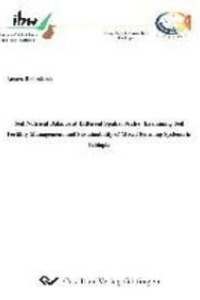
Liknande böcker
Assessing successive leaf yield performance of dual-purpose cowpea (Vigna unguiculata) to decrease seasonal shortage of nutrients in resource-poor small-scale households of Tanzania and Uganda
Bok av Severin Polreich
This study presents a method to assess yield performance of dual-purpose cowpea types for human consumption and to reveal potentials for further improvement of its use as leafy vegetable. Eleven cowpea accessions with different genetic background and sample status were chosen from AVRDC s working collection in Arusha, Tanzania. Among them, dual-purpose cowpeas like Dakawa, Ex Iseke and Ngoji were present that the center has been distributing to local farmers. Multi-location trials in typical cowpea production environments were established both on farm and on station in the regions Arusha, Dodoma, and Kilimanjaro in Tanzania and in Eastern Region, Uganda during the short and long rainy season 2007 and 2008, respectively. Young, tender leaves were picked in successive leaf harvests about every and two weeks until the plants did not produce further leaves. Cowpea seeds were harvested when pods reached 80% maturity. Data of yield parameters were analyzed with analysis of variance (ANOVA), stability analyses were carried out according to the dynamic and static concepts. Reliability of leaf and seed yield performances were calculated based on the probability of outperformance of local check cowpeas that were previously recommended by farmers and extension workers in informal group sessions. Through NIRS, crude protein and iron contents were assessed in leaves obtained from the second leaf harvests at the different locations and from up to subsequent leaf harvests. Dual-purpose utility for smallholders was assessed through (i) an index of superiority (Si), in which reliabilities of leaf yield across repeated leaf harvests and seed yield were weighed and combined to overall yield benefit of the ith accession, (ii) effective plot length for nutritional component XY, to calculate the length of a plot (in m) that needs to be planted to sustain a five-head household for ten days with a recommended amount of nutrients, and (iii) responsiveness (Resp), reflecting changes of leaf yield (compensation) relative to changes in seed yield (sensitiveness) if harvesting frequency was intensified. Performance of single leaf yields was strongly influenced by environmental factors and, only in Arusha, accession-specific. Interactions between yield reliability and stability were site-specific. Overall, test-accessions achieved higher reliabilities in seed yield than in leaf yield. Only in the on-station trial in Eastern Region, accession IT82D-889, and in the on-farm trial in Kilimanjaro, ILRI11114 and Ex Iseke showed leaf yield reliabilities above 0.50. Iron content in cowpea leaves was highly dependent on environmental influences and varied from 157.4 mg kg-1 to 286.1 mg kg-1. Leaf CP had a broad-sense heritability of 0.87. Across accessions and environments the mean leaf CP content ranged from 37.4% of DM (IT93K-2045-29) to 33.9% of DM (Sudan). CP and leaf dry matter (DM) yield had significantly negative correlation coefficients between. Means of effective plot length for crude protein and iron varied by more than 50% across environments. Although CP, in contrast to iron, was genetically determined, its impact on differences in effective plot length was negligible as well, as differences in production of leaf DM per m2 were by far larger among accessions than those of CP contents. It was recommended to favor accessions with short effective plot lengths and higher CP contents in leaf yields over those with short effective plot lengths and low CP contents. In contrast to determinate cowpeas, indeterminate types increased their DM gain in aerial plant parts of leaf-harvested plants relatively to unharvested plants. Indeterminate cowpeas responded with high leaf yield increases if leaves were picked twice a week. Consequently yields of total edible DM of these plant types, comprising added seed and leaf yields, increased with intensification of leaf-harvesting frequency from once to twice a week. Determinate plant types yielded highest in total edible







